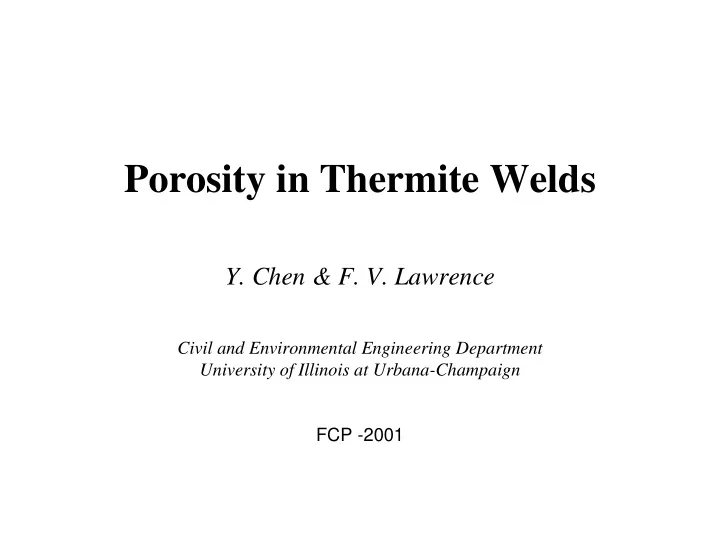

Porosity in Thermite Welds Y. Chen & F. V. Lawrence Civil and Environmental Engineering Department University of Illinois at Urbana-Champaign FCP -2001
What is Thermite Welding? • Thermite weld -- A welding technique to utilize Aluminothermic reaction to join massive industrial components. • Aluminothermic reaction: 3 FeO + 2 Al = 3 Fe + Al 2 O 3 + 783 KJ / mole Fe 2 O 3 + 2 Al = 2 Fe + Al 2 O 3 + 759 KJ / mole 3 Fe 3 O 4 + 8 Al = 9 Fe + 4 Al 2 O 3 + 3010 KJ / mole 2
What is Thermite Welding? • Equipment used for thermite rail welding: 3
Thermite Charges • Iron oxide particles – with ferroalloy pellets • Aluminum powder – 10~15% in excess of stoichiometric amount – Size: 3- 500µ m • Additives – help slag-metal separation 4
Problems associated with Thermite welds • Low tensile ductility – Rails : 14% reduction area. – Thermite welds : 1~3% reduction area. • Low impact toughness – Rails : ~ 6 J Charpy V-notch. – Thermite welds : 1.5~2.8 J Charpy V-notch. • Coarse grain, dendrite microstructure. • Inclusion and porosity – Develop internal fatigue cracks, and offer easy crack propagation path. – Pores are much more serious defects. 5
Porosity and fatigue strength 6
Source of porosity in thermite welds • Dissolved gases in molten metal. – Due to small solubility of gas element in solid metal. – Form tiny, distributed gas pores in welds. – Weakly depends on solidification pattern. • Gas pores – Trapped gas during pouring. – Chemical reaction products (eg. CO, CH 4 ) – Relatively large pores. – Depends on solidification condition and impurity. • Shrinkage pores – Volume contraction during solidification. – Very large pores, or pore cluster. – Strongly depends on solidification condition. 7
Measurement of porosity content N_3 F_1 Radiographs of thermite welds 8
Measurement of porosity content Optical measurement of Thermite welds N_3 N_6 9
Measurement of porosity content Table 1 : Porosity content in thermite weld. Sample Name L_1 F_1 F_3 F_4 N_1 N_2 N_3 N_6 N_7 N_8 Porosity (vol.%) x-ray 0.84 0.92 0.4 0.4 0.6 0.96 1.2 0.4 0.56 0.56 optical 0.93 1.01 - - - - 1.28 0.48 - - • There is a wide variation of porosity content in different welds. • Porosity content measured by radiograph method is lower than that of optical measurement. 10
SEM observation S Mn inclusion Mn Fe Fe Matrix Al Al inclusion 11
SEM observation SE BSE X-ray mapping of inclusions in welds Al K α S K α Mn K α Fe K α 12
Porosity distribution Grey-scale variation across sample 6 10 4 Arbitrary Grey-scale 5 10 4 Arbitrary grey-scale (black=0, white=65535) 4 10 4 3 10 4 L_1 2 10 4 1 10 4 0 -1 -0.5 0 0.5 1 Arbitrary distance from center Arbitrary distance from center 13
Porosity distribution and preheat 10 mm Long preheat (7 min) 14 Short preheat (2 min)
Width of melt-back Fusion width and standard deviation across thermite weld 20 Rail head Width of meltback (cm) 15 10 5 Rail base 0 0 2 4 6 8 Distance from the rail base (cm) 15
Summary 1. Porosity content in thermite welds is measured by radiography method. Because of the present of Al 2 O 3 , radiograph method underestimates the total porosity content. 2. There is a wide variation of porosity content in different welds. 3. Pores are very often associated with inclusions. 4. Porosity cluster is often observed along centerline of weld. 5. Preheat time can affect the formation centerline porosity cluster. 16
Future work • Modeling the thermite welding process (2-D and 3-D). – Effect of preheating: flame temperature + time. – Influence of tapping time. – Heat input: amount of thermite charges. – Ambient temperature. Weld Heat flow Interface temp. Melt-back T in T m Time preheat tap solidification cooling 17
Future work • Understand the key controlling factors for thermite welds, and what can be done to improve. • Experimentally fabricate thermite weld in a well controlled environment and verify the theoretical study. 18
Recommend
More recommend